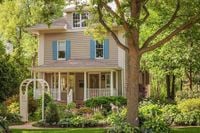When it comes to selling your house, curb appeal is touted as one of the most important features for drawing in potential buyers. But before you rush out to your front yard and spend hundreds or thousands on unnecessary upgrades, listen to the experts. There are some curb appeal updates that will help sell your home faster and for more money, but there are others that won’t offer a return on investment and could actually hurt the value of your home. Here, experts offer tips on which curb appeal updates to go for and which to skip.
One common mistake homeowners make is painting exterior brick. While a fresh coat of paint on your front door can add a pop of color, painting features of your home that don’t require paint can be a bad move, especially when it comes to brick. “Painting exterior brick, regardless of what color, can be a red flag for some buyers,” says Jason Strat, senior real estate agent at Rocket Homes. “Natural brick requires little to no maintenance, while painted brick will need to be repainted every three to five years. This added maintenance might be a dealbreaker for buyers interested in a low-maintenance exterior.”
When it comes to paint colors, it’s best to avoid dark or overly bright colors. Albert Safdie, an agent at Coldwell Banker Warburg, advises sticking with classic, timeless tones that complement the neighboring properties. “If I were painting a house for curb appeal, I would venture towards white, cream, and dark green,” says broker Ellen Sykes of Coldwell Banker Warburg. “I would stay away from purple, orange, yellow, brown—if not in a woodland setting, red and black.” New paint could also be a bad thing for potential buyers if you choose a unique color. “Potential buyers may factor in the future cost of repainting the entire exterior,” Safdie adds. “This can ultimately impact the perceived value of the home and lead to a lower purchase price.”
Landscaping is another area where homeowners can enhance curb appeal, but experts caution against poorly-placed trees and shrubs. Flowers and fresh mulch work wonders in a front yard to make your home look inviting and well taken care of. However, planting trees too close to the house can raise concerns for buyers. “They might worry about future damage to the exterior or roof and see tree removal as an additional expense they’ll need to deal with later,” Strat warns. Sykes points out that the placement of particular plants is also key. “Rows of round boxwood shrubs and mountain pines placed strategically in the garden beds disrupt the enjoyment of a pretty garden,” she says. “Putting trees in front of windows is also a mistake—you can’t see outside, and it makes the house dark.”
As you work on your home’s curb appeal, it’s wise to make improvements to damaged siding, overgrown flower beds, rusty mailboxes, and squeaky screen doors. However, it’s important not to over-customize the look and feel of your home if it means alienating a large group of potential buyers. “While such additions may be well-intentioned, what one homeowner sees as creative or luxurious might not align with a buyer’s taste,” Safdie cautions. “It’s best to keep architectural elements classic and neutral, allowing for future owners to customize the home to their liking.” In New York, for example, one homeowner added a skylight above a bathtub, which allowed for natural light but raised privacy concerns for some buyers.
A recent trend has been to replace front doors with larger ones. While this might create a show-stopping facade, experts say bigger isn’t always better. “If the house is huge, then a large and elaborate front door installation could be in proportion and appropriate,” Sykes explains. “Putting them on a small to medium-sized house throws the proportions off.” Instead, experts recommend opting for a new door that is the right size and shape. “Stick with a nice door, not too large, and perhaps window panes on either side,” Sykes suggests.
Lighting is one of the best ways to highlight features of your home and improve curb appeal. Experts typically recommend adding spotlights to showcase landscaping and walkway lights to illuminate paths leading to your front door or backyard. “I’ve seen properties with spotlights thoughtfully placed throughout the landscape, creating a truly magical atmosphere at night,” Safdie notes. But the trick to a good return on investment is to opt for affordable lighting upgrades. “While this lighting effect can be stunning, it's important to understand the long-term implications,” he adds. Outdoor lighting systems can be costly to install and maintain, especially in regions that experience wide temperature fluctuations and harsh seasonal conditions. “Repairs to exposed electrical systems require specialized labor and can add unexpected expenses for future homeowners,” he warns.
As the home design landscape evolves, another trend gaining traction is the emergence of specialty spaces within homes. Mary Peters, founder and CEO of Sasquatch Contracting, notes that homeowners are increasingly seeking designated spaces that serve specific purposes. “We’re seeing a desire for carved-out nooks that serve a purpose and segregate activities,” Peters explains. This shift in preference can largely be attributed to changes in lifestyle brought on by the COVID-19 pandemic. Instead of keeping floor plans open for general use, homeowners are curating their homes to fit their interests.
Specialty spaces can enhance focus and provide a peaceful environment for various activities, from home offices to meditation rooms. Peters emphasizes, “Special spaces are functional spaces, and can help enhance your focus.” For instance, morning rooms, typically located near a primary bedroom, are small, flooded with natural light, and secluded, making them ideal for enjoying a quiet moment with a cup of coffee or reading the news.
Common themes in specialty spaces include soundproofing, which is increasingly important for activities such as video gaming or podcast recording. Peters recalls a successful renovation where a closet was transformed into a dry bar, highlighting the potential of underutilized spaces. “Think outside of the box and find potential in any extra space,” she advises.
When creating a specialty space, consider the purpose and location carefully. Peters suggests using unusual areas to your advantage, such as under-stair storage spaces that can become charming reading nooks. Lighting also plays a crucial role; using daylight bulbs for study rooms and soft whites for dining areas can create the right ambiance. Additionally, using high gloss paint can give a space a high-end feel, while strip lighting in baseboards adds a unique touch to game rooms and theaters.
In the end, whether enhancing curb appeal or creating specialty spaces, homeowners must strike a balance between personal taste and broader market appeal. By following expert advice and considering future owners' perspectives, they can make informed decisions that not only beautify their homes but also enhance their resale value.




